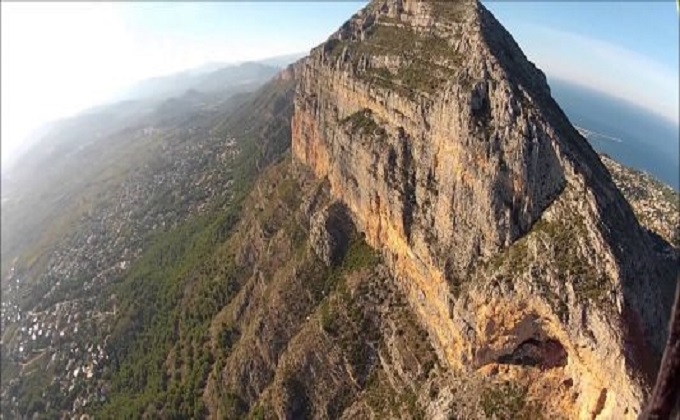In addition to its rich landscape, flora and fauna, in the Montgó there are several cavities within the official routes marked by the Natural Park. Without a doubt, the best known and most visited is the Cova Tallada , a sea cave at the foot of the cliff of Cabo de San Antonio. But there are more – both in Dénia and Javea.
Location plan
This is a map of the Institut Cartogràfic Valencià , in which the routes to the caves are indicated in different colours. . Routes to the Montgó caves (Source: Institut Cartogràfic Valencià)

The Caves of Dénia
In Montgó Natural Park there are the caves of Agua, del Gamell and the lesser known Cova de la Punta de Benimaquia.
Cova de l’Aigua – The Water Cave
La Cova de l’Aigua (in Valencian) corresponds to the yellow route on the map. You can get there on foot from the same urban area of Dénia, or go up by car and park in the Ermita del Pare Pere, then continue by foot. At this point the uphill path begins, a journey of between 30 and 45 minutes that is especially worth it for the panoramic views of Dénia.

The cave is on the north face of Montgó, about 350 metres high. At the entrance there is a Roman inscription dating from 238 AD, unfortunately in quite poor condition. It has two cavities and a small pond at the bottom.
Once seen, return by the same path or continue the circular route along the Camí de la Colònia and the Cova del Gamell .Cova de l’Aigua, on the north face of Montgó
The Cova del Gamell
Do not get confused and call it Cova del camell (camel in Valencian). There is some inaccuracy when it comes to naming it, but the truth is that its name is due to the gamell , an object used to feed goats and sheep. To get there, follow the Camí de la Colònia, which is the blue route marked on the map above. The cave is at the end of this path.

The Cova of the Punta de Benimaquia
This is the least known and smallest cavity. It is part of the light green route, the one that goes from the path of Mitjans in Jesús Pobre to the top of Montgó. It is a just a one metre diameter mouth, which after descending 1.5 meters, gives way to a circular duct through which you reach a room about 20 metres wide by 8 metres high.
The caves of Jávea
Among them, we find the famous Cova Tallada, and also the Cova del Montgó, the place where the oldest remains of settlers have been found on the Montgó.
The Cova Tallada – The Carved Cave
The Cova Tallada is different from the other Montgó caves, in terms of natural environment, since it is a sea cave, and in terms of number of visitors, much greater. It belongs to the municipality of Javea, but its easiest access is through Dénia: exactly from the end of Les Rotes , very close to the Mena Restaurant , on C/Vía Láctea.

It can also be reached by sea, kayak or canoe. It is very important to note that currently the Cova Tallada has important restrictions to visit it: between June 15 and September 30, it can only be accessed by reservation.
Cova del Montgó
The Cova del Montgó , also called Cova Ampla (wide cave, in Spanish), is located about 450 metres above sea level on the southern slope of the Montgó. The first archaeological evidence of settlers on the Montgó come from it, and are from the Upper Paleolithic, that is, from about 30,000 years ago.
The road to Cova del Montgó is not within the routes established by the Natural Park, but there is a route that leaves very close to the official path to the top. Denia.com explains how to travel through it and how to find it.



